#Arie de Jongh
Explore tagged Tumblr posts
Text
Herontdekte zedeloosheid
Soms is het portret van iemand beroemder dan de geportretteerde zelf. Dat geldt voor de Duitse danseres Anita Berber (1899-1928), die in het Berlijn van de jaren na de Eerste Wereldoorlog triomfen vierde – niet alleen vanwege haar danskunst, maar met name ook vanwege haar onstuimige, van alcohol en cocaïne en andere verdovende middelen doortrokken levenswijze. En natuurlijk door de naaktdans…
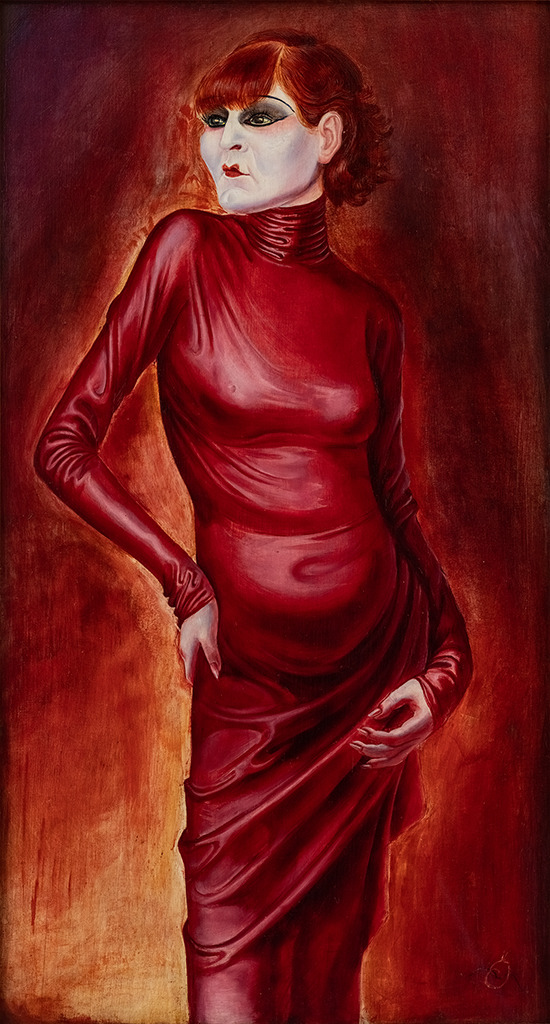
View On WordPress
#Alexander Binder#Amy Winehouse#Anita Berber#Arie de Jongh#Berlijn#Charlotte Köhler#cocaïne#Colette#Colette Andris#dans#Henri Chatin Hofmann#Isadora Duncan#James Klein#Jaren Twintig#korset#Lea de Putti#Magnus Hirschfeld#Marlène Dietrich#Max van Gelder#naaktdans#naturisme#Otto Dix#Richard Oswald#Rosa von Praunheim#Schnitzler#Sebastian Droste#UFA#Waldemar Titzenthaler
1 note
·
View note
Photo
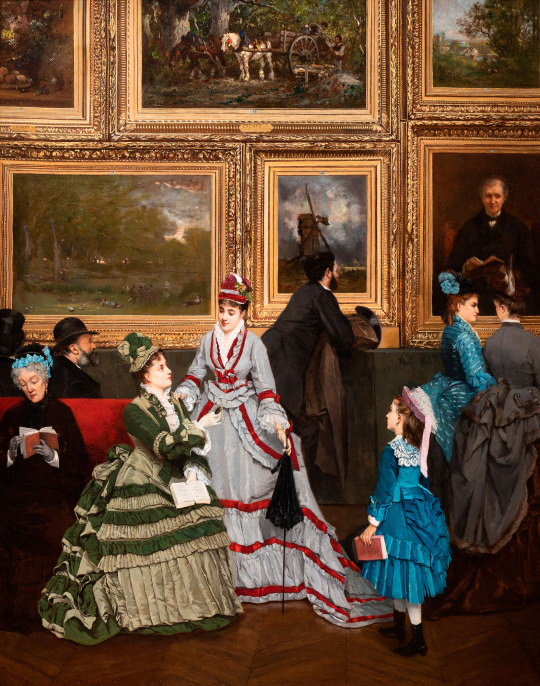
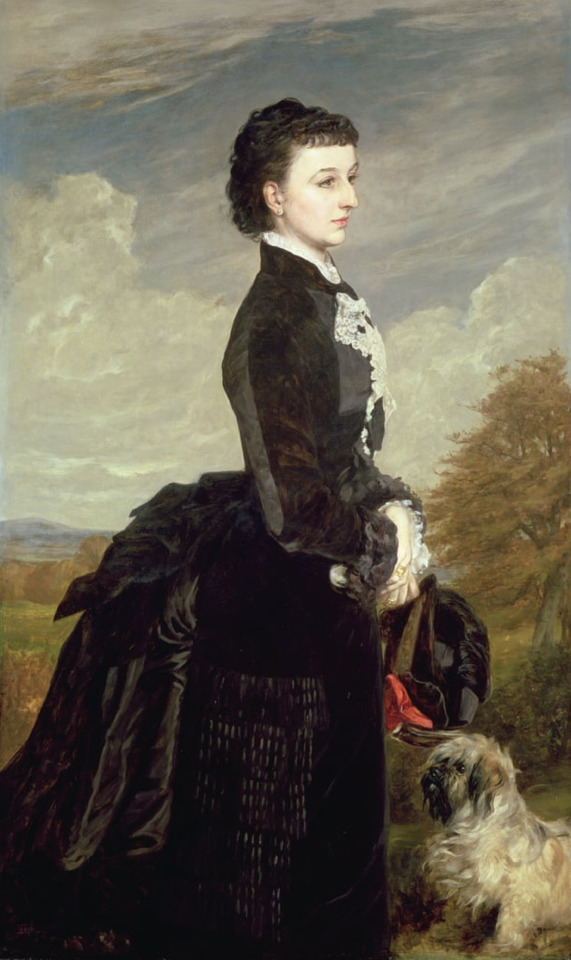


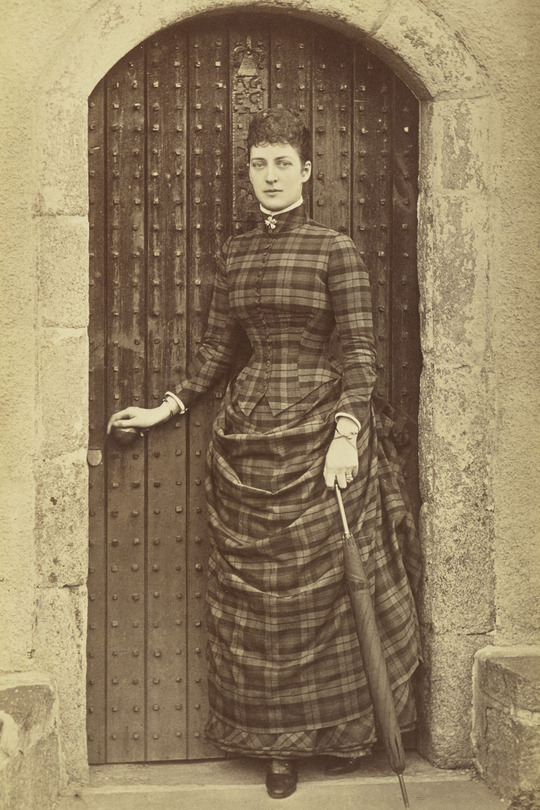
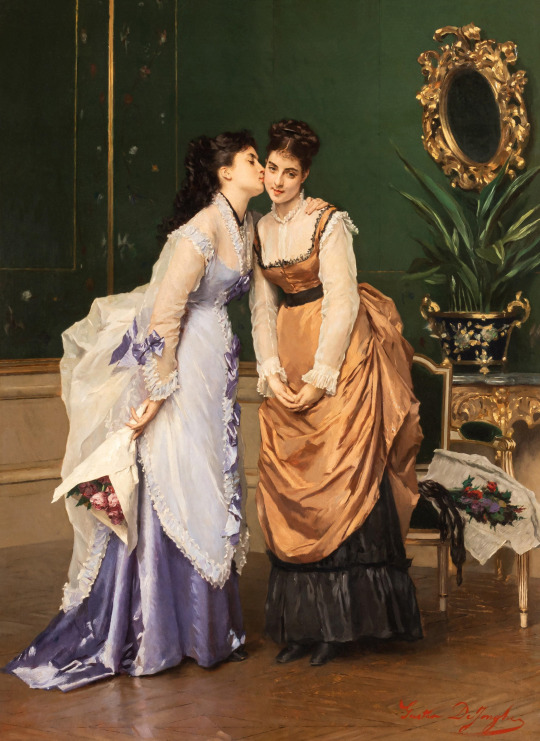
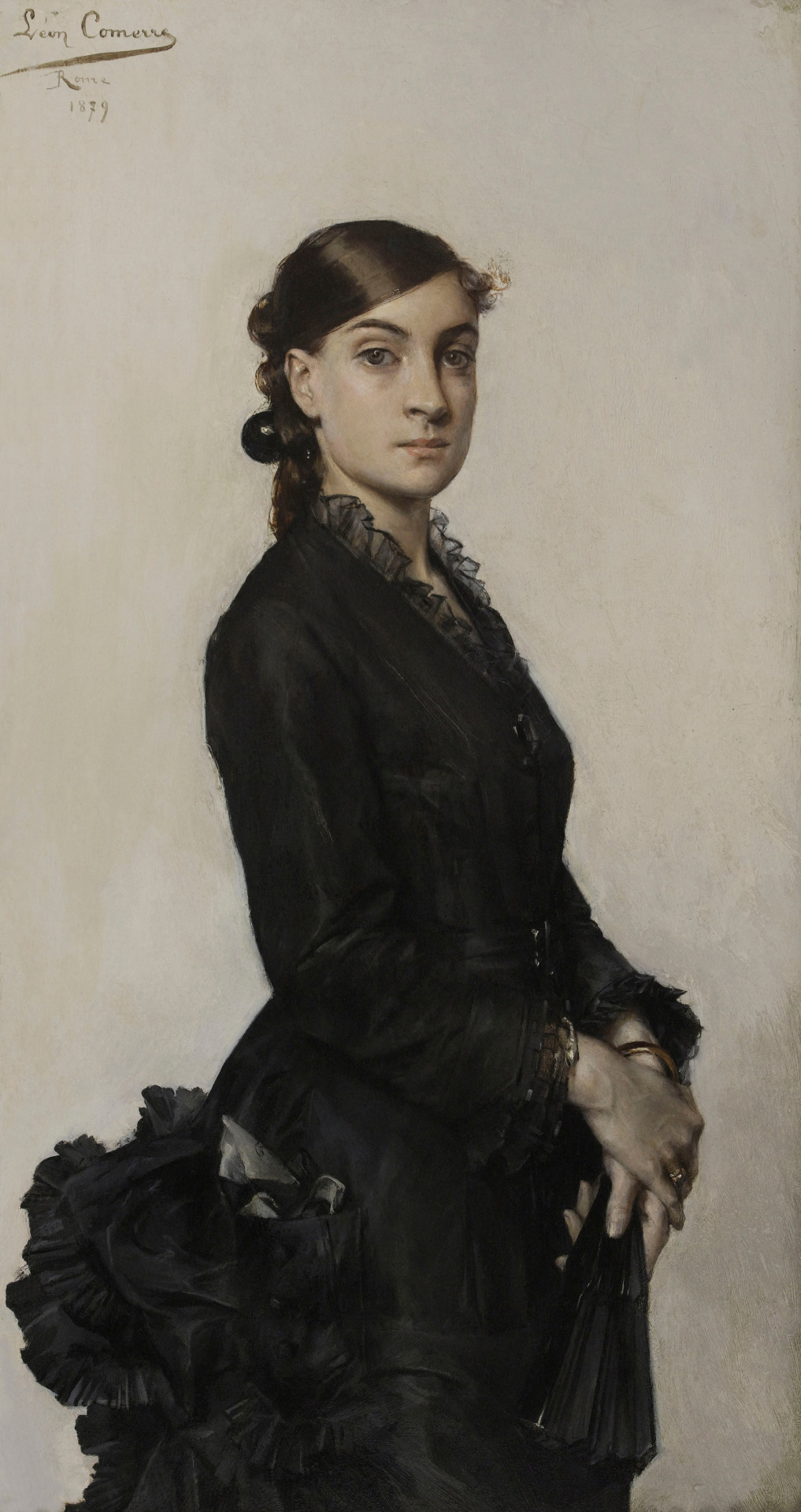
Middle and Late 1870s (from top to bottom) -
Le Salon de 1874 by Camille-Léopold Cabaillot-Lassalle (on sale at Ary Jean Art Gallery). From their Web site 1574X2000.
1875 Lady in Black with a Dog by James Archer (location ?). From meisterdrucke.de-kunstdrucke-James-Archer-197600-Porträt-einer-Dame-in-Schwarz-mit-einem-Hund,-1875 2308X3878.
1877 Toilette by Jules James Rougeron (Tokyo Fuji Art Museum - Tokyo, Japan). From facebook.com/MimiMatthewsAuthor/photos/toilette-by-jules-james-rougeron-1877-this-is-the-painting-thats-on-the-cover-of/2377279908990463/ 1174X1725.
Florentia Maria Crawshay 1849-1920), née Woods, as a Young Woman by ? (Cyfarthfa Castle Museum & Art Gallery - Merthyr Tydfil, Merthyr Tydfil, UK). From Wikimedia; fixed more obvious spots w Pshop 936X1200.jpg,
Princess of Wales Alexandra by W. & D. Downey (Royal Collection). From teatimeatwinterpalace.tumblr.com/post/167945509352/queen-alexandra-when-princess-of-wales-x 540X810.
Two elegant sisters in a luxurious interior by Gustave Léonard de Jonghe (location ?). From tumblr.com/artthatgivesmefeelings; fixed spots & some cracks w Pshop 2048X2809.
1879 Jacqueline Paton en robe noire by Léon Comerre (location ?). From tumblr.com/random-brushstrokes; fixed spots & flaws w Pshop 1627X3072.
#1870s fashion#late Victorian fashion#bustle period fashion#Camille-Léopold Cabaillot-Lassalle#hat#curly hair#blouse#jacket#bustle#flounces#stripes#James Archer#long sleeves#Jules James Rougeron#tablier#Florentia Maria Crawshay#bateau neckline#cap sleeves#fur boa#Queen Alexandra#W. & D. Downey#clerical neckline#plaid#Gustave Léonard de Jonghe#square neckline#yoke neckline#Jacqueline Paton#Léon Comerre
121 notes
·
View notes
Text
Theeschenkerij De Nachtegaal in het Kralingse Bos, 1969.
De directeur Gemeentewerken, G.J. de Jongh, ontwerpt in het begin van de 20e eeuw een plan voor een bos of stadspark langs de Noorderplas, zoals de Kralingse Plas in die tijd wordt genoemd. De oorspronkelijke naam van het park is de Kralinger Hout. In 1911 wordt het plan door de gemeenteraad aangenomen. Men zal de polders ophogen met slib en baggerspecie die men over zal hebben van het graven van de Waalhaven.
Doordat de aanleg van de haven door de Eerste Wereldoorlog vertraging oploopt, duurt het even voordat de plannen van de grond komen. In 1921 maakt de architect Marinus Jan Granpré Molière een nieuw ontwerp. Vanaf 1928 is de grond eindelijk voldoende opgehoogd, en begint men met het planten van speciaal in Noord-Brabant gekweekte eiken. De Rotterdamse schooljeugd wordt hierbij ingezet op speciale boomplantdagen. In de jaren dertig van de 20e eeuw worden er in het kader van de werkverschaffing ook werkelozen ingezet bij de aanleg en beplanting. Een groot deel van deze bomen wordt tijdens de hongerwinter opgestookt in de kachel. Het vele puin, afkomstig uit het centrum van de gebombardeerde stad, wordt gedumpt in de zuidelijke hoek van de Plas. Zo ontstaat een groep kleine eilanden, die ten behoeve van wandelaars worden verbonden met een reeks loopbruggen. In 1953 wordt het Kralingse Bos dan eindelijk officieel geopend.
Het bos verwerft grote bekendheid in de zomer van 1970 vanwege het Holland Pop Festival, het 'Europese antwoord op Woodstock'. Internationale bands die er optreden zijn onder meer Pink Floyd, The Byrds, Santana en Focus. In totaal zijn er meer dan 100.000 bezoekers.
De fotograaf is Ary Groeneveld en de foto komt uit het Stadsarchief Rotterdam. De informatie komt van Wikipedia.

0 notes
Text
books read in June 2024:
Revenge of the Librarians by Tom Gauld
Nothing Can Possibly Go Wrong by Prudence Shen
The Return of the Honey Buzzard by Aimee de Jongh
Youthjuice by E.K. Sathue
Always Human by Ari North
The Goth House Experiment by S.J. Sindu
You Glow in the Dark by Liliana Colanzi
Hotelitor by Josh Hicks
Supes Ain't Always Heroes edited by Lynn S. Zubernis
Alex + Ada vol. 1 by Jonathan Luna
How to Say Babylon by Safiya Sinclair
Honey by Isabel Banta
Home Field Advantage by Dahlia Adler
Everyone is Tulip by Dave Baker
Superman: Last Son of Krypton by Geoff Johns
My Mechanical Romance by Alexene Farol Follmuth
The Secret Lives of Sports Fans by Eric Simon
0 notes
Text

Gustave de Jonghe (b.1829 - d.1893), 'Entertainment', oil on panel, c.1866, Belgian, for sale for 38,000 EUR at Galerie Ary Jan, Paris, France.
#gustave de jonghe#unknown sitter#known artist#oil on panel#1860s#belgian#galerie ary jan#paris#cat#interior
21 notes
·
View notes
Quote
Kadang sengaja agar dia tak tau. Sengaja menukar hari. Agar ungkapan ini tiada yang tau. Now playing: Sedang sayang sayangnya (mawar de jongh). Pura pura lupa (mahen). Cara lupakanmu (gisel). Tanya hati (pasto). Hampa (ari lasso). Rindu dalam hati (arsy & jodie)
1 note
·
View note
Text
Elise Cooper Interviews Kristin Hannah
The Nightingale by Kristin Hannah is a must read for anyone who has never read this historical novel that was first published in 2015. While people are locked down they might want to pick up this novel, which is very relevant to today considering that Yom HaShoah, The Holocaust Martyrs’ and Heroes Remembrance Day, has just been observed. The plot has two sisters who are both heroic and martyrs for their unselfish acts.
Vianne and Isabelle embarked on their own dangerous path that included survival, courageousness, love, and resilience. They showed incredible strength during these terrible times in Nazi-occupied France.
The story begins in 1995 as one of the sisters tells what happened to her and her sister starting in 1939 France. In the quiet village of Carriveau, Vianne Mauriac says goodbye to her husband, Antoine, as he heads for the Front. When a German, Captain Beck, requisitions Vianne's home, she and her daughter Sophie must live with the enemy or lose everything. Without food, money or hope, she is forced to make one impossible choice after another to keep her family alive. Through her eyes, readers understand the brutality of the Germans as they loot, steal, beat, and starve the French population. Even worse, the French Jews were being deported to concentration camps. This is where Vianne decides she must risk her and her daughter’s life by taking in a Jewish baby, her best friend’s son, when his mother is sent to a concentration camp. After Captain Beck disappears another German, a Gestapo Agent, Sturmbann Fuhrer Von Richter, requisitions their home, brutally forcing Vianne to acquiesce to his male desires. Knowing she can no longer stay on the sidelines, Vianne decides to save nineteen Jewish children by hiding them in a convent and creating false identity papers. But her heroics are personal as well, enduring severe brutality to keep her children alive and to find word about her captured husband.
Her sister, Isabelle, is no less brave. She meets Gäetan, a partisan who believes the French can fight the Nazis from within France. As she falls in love with him, she feels betrayed when he deserts her at her sister’s home. Isabelle joins the Resistance and never looks back, risking her life time and again to save others. She refuses to accept France's surrender despite her sister's pleading to stay quiet and safe. As things take an unexpected turn, she decides to take matters into her own hands, and joins an underground group, The Resistance, that risks their lives to fight the Nazis. From now on, she becomes Juliette Gervaise, code name the Nightingale. Isabelle volunteers for dangerous duty, shepherding downed Allied airmen across the Pyrenees to Spain.
After reading this book readers will understand what the French citizens and Jews went through at the hands of the Nazis. A quote by Vianne summarizes how people behave when confronted by adversity, “In love we find out who we want to be; in war we find out who we are.” This is not just another World War II novel, but delves into how women made an imprint on the war. Having been given a great deal of hype, a reader might question if it can live up to its publicity. It actually did more than that, it surpassed it, and is still surpassing it.
Elise Cooper: What was your thought process in developing the storyline?
Kristin Hannah: It started out to be Isabelle’s story. My original idea was to write about those women who helped downed Allied airmen get out of occupied France during World War II. As I was doing the research I found out about the hidden Jewish children. Ultimately, I decided I couldn’t write a book about heroic women of WWII without including this storyline. When I had the book tour for this event, I had people coming up to me who told me they were a hidden child. Interestingly, it is still not talked about a lot.
EC: Why the setting in France?
KH: Because the original story was about the downed airmen and that primarily happened in France. I also read Sarah’s Key by Tatiana de Rosnay that told a story about the Holocaust. It alternated between a ten-year-old French Jewish girl and an American journalist who wants to tell her story. I also wanted to explore the difference between occupied France and the non-occupied portion. France has not really owned up to what they had done during the war until rather late.
EC: The pictures at the end of the book?
KH: My husband and I took a trip there for five weeks. We started in Paris and followed Isabelle’s route as she helped the Allied airmen escape. I hope the reader is able to picture in their heads what I pictured in mine.
EC: Did you explore the issue of motherhood?
KH: Yes, and how it impacts courage and heroism. It was easier for Isabelle to be heroic, brave, and a risk-taker because she was only endangering her own life. Her sister, Vianne, represents the fundamental position of the novel, “When would a wife and mother, risk their life, and more important, their child's life to save a stranger?”
EC: Did you answer that question?
KH: Yes, because this was crucial to making the book work. For me, it came down to the idea, would I want to live in this world or would I rather die than raise my children in a world like that? This is when I would put my children’s life at risk.
EC: Can you compare the two sisters’ heroics?
KH: Vianne did what a lot of people did, become heroic by degree, one small piece at a time. She asks herself if she would risk taking her Jewish best friend’s child and answers yes. She then does it again for another child and rescues more Jewish children. She was on a dangerous path even more because there were Nazis living in her house. Her story was based on a composite of various women who hid Jewish children.
Regarding Isabelle, she might have rescued the airmen because she related to them due to her own abandonment issues. She was young so she was a lot more willing to upset the status quo. In some ways, I am not sure she understood her own risks. I based her story on a Belgium woman named Andrée de Jongh, an amazing woman who repeatedly risked her life helping British and American servicemen escape on foot from Nazi-occupied Belgium and France.
EC: How would you compare the two Nazis, Von Richter and Beck?
KH: Von Richter was easy to write. He fits the stereotype of what we picture a Nazi to be. I wanted to contrast him with a character that was a little more unexpected, Beck. In some ways he was humane, like when he brought the fake ID for the deported friend’s Jewish child, Ari. I wrote this quote, “You needn’t worry, Madame,” he said. “We have been admonished to act as gentlemen. My mother would demand the same, and, in truth, she scares me more than my general. It was such an ordinary remark that Vianne was taken aback.” But other times he was cruel as he whipped the Jews going into the trains headed for the Concentration Camps, or hoarding food even though he knew Vianne and her children were starving.
EC: Another conflicting character were the sisters’ father, Julien?
KH: He represented how those who fought in WWI felt, considering WWII came on the heels of WWI. The generation of Frenchmen were decimated by the First War. Bust as things happened in WWII he had to decide if he would risk his life for his children. This is when he steps into the heroic role.
EC: Through Isabelle’s character you show some of the brutality of the German Concentration Camps?
KH: I put in this quote, “They broke my body in the first days, but not my heart.” When speaking to survivors a theme that comes up time and again is that their spirit survived. It is impossible to understand what was done, how the Germans were willing to kill people to further their beliefs. The ending came out of wanting to show what the risks were that this family took.
EC: The role of women?
KH: What protected both sisters were that they were women. There was an assumption that women could not do these things. The arrogance of the Nazi soldiers had them assume they had control over everything. Because they were not looking at women, things went undetected, and they did not expect the women to step up. It worked really well in the first years of the war.
EC: An author once said, “greatness comes about when people are presented with incredible problems and are judged on how they will rise or fall.” Do you agree?
KH: Yes, this is perfect. I love that because it is a representation of the two sisters. I hope readers understand what life was like under Nazi rule. How women did what they did to survive, saving their own lives, their children’s live, but other lives as well.
EC: What are your next projects?
KH: Out in the fall of this year is a Netflix series based on my book, Firefly Lane. I think the production did an amazing job. It is about two women who became best friends in the 1970s, soulmates for the rest of their lives.
There will be a movie from The Nightingale book. They were literally two days from starting to film in Hungary when production was shut down because of the virus. The hope is that filming will start again in September. I read the script for it and thought it was lovely because it told the story and honored the characters. I did have input regarding the script. The director reached out to me for questions. I feel like I was kept a part of the process.
My next book will be out in early 2021. I am embargoed to speak about it but can in two weeks so check back then.
THANK YOU!!
0 notes
Text
Bulan Depan, Ari Lasso Manggung Bareng Dul Jaelani
Bulan Depan, Ari Lasso Manggung Bareng Dul Jaelani
Dailymail.co.id, Jakarta Ari Lasso, mantan vokalis grup musik Dewa 19 ini sempat ikut berpartisipasi dalam konser Dewa 19 di Malaysia beberapa waktu lalu.
Pada konser tersebut, Ari Lasso yang membawakan lagu "Hadapi dengan Senyuman", memecah tangis anak-anak Ahmad Dhani. Mengingat ayahnya harus mendekam di jeruji besi, akibat kasus pencemaran nama baik.
Demi Bumi Manusia, Mawar Eva de Jongh…
View On WordPress
0 notes
Photo

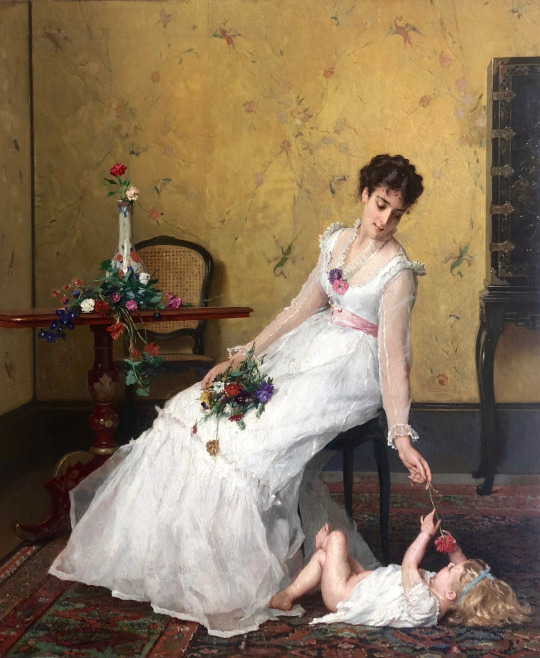
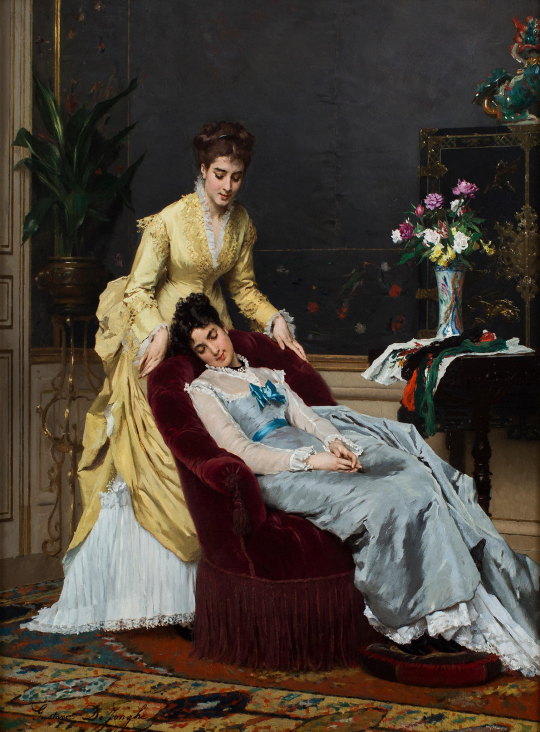
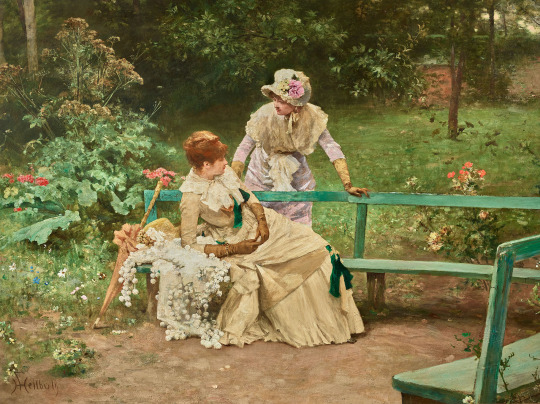
Dresses from Around 1880 (from top to bottom) -
Awaiting the suitor by Gustave Léonard de Jonghe (location ?). From Yulia Mi's photostream on flickr; fixed spots & some cracks w Pshop 2060X2880.
Joie maternelle by Gustave Léonard de Jonghe (location ?). From tumblr.com/artthatgivesmefeelings 1576X1920.
Sweet dreams by Gustave Leonard de Jonghe (location ?). From Yulia Mi's photostream on flickr 1510X2048.
The confidence by Ferdinand Heilbuth (on sale at Ary Jean Art Gallery). From their Web site; fixed biggest spots wPshop 1961X1467
#late Victorian fashion#1870s fashion#1880s fashion#curly hair#Gustave Léonard de Jonghe#tablier#ruffles#V neckline#waist band#Ferdinand Heilbuth#hat flowers#mantle#high neckline#close skirt#gloves
62 notes
·
View notes
Photo
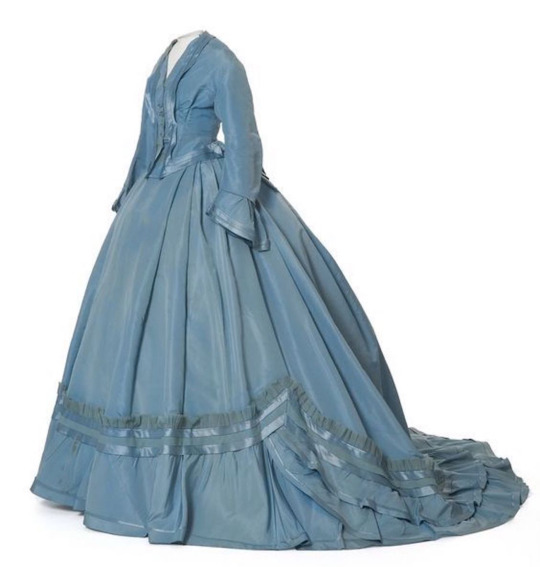

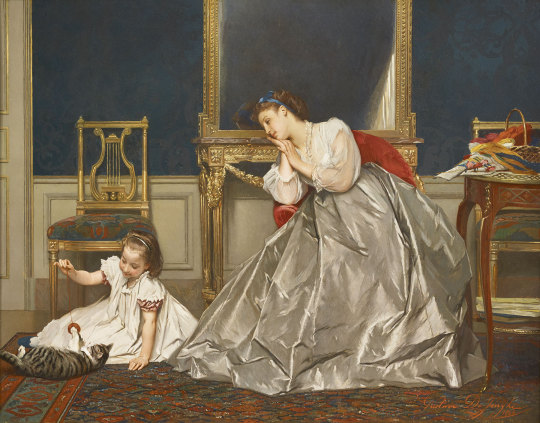
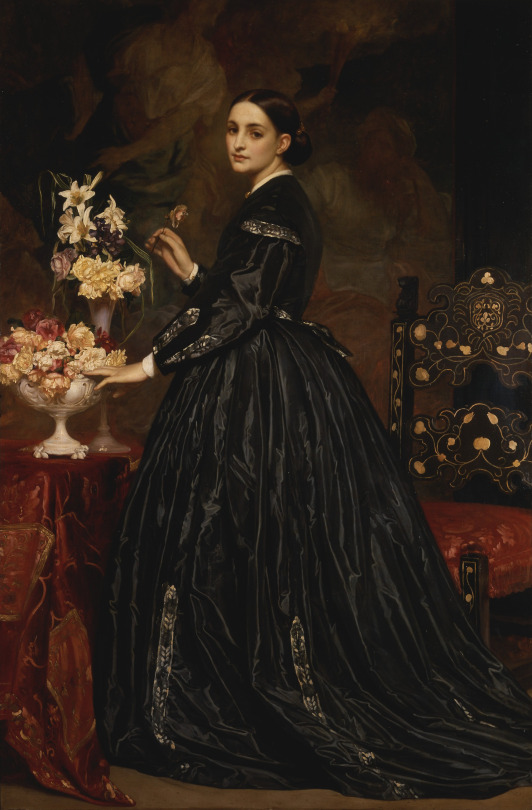
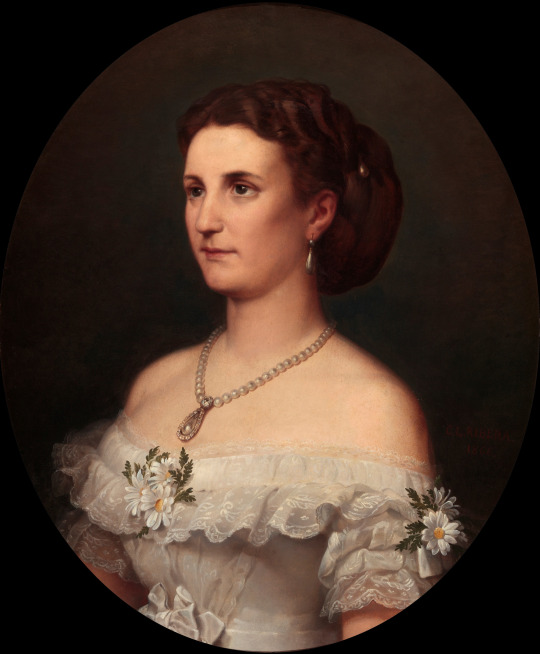
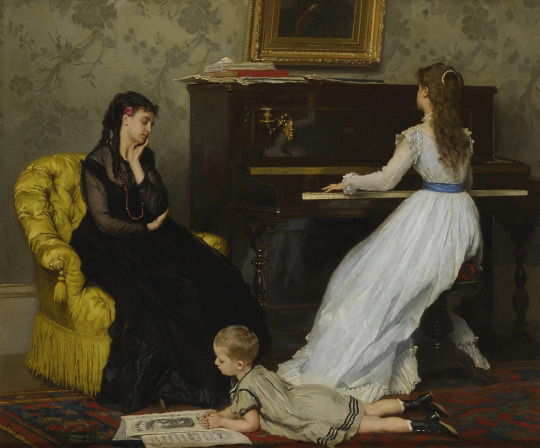
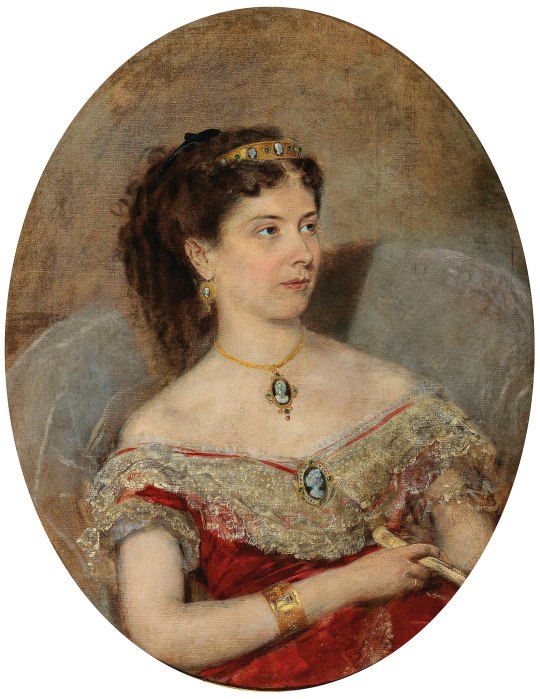
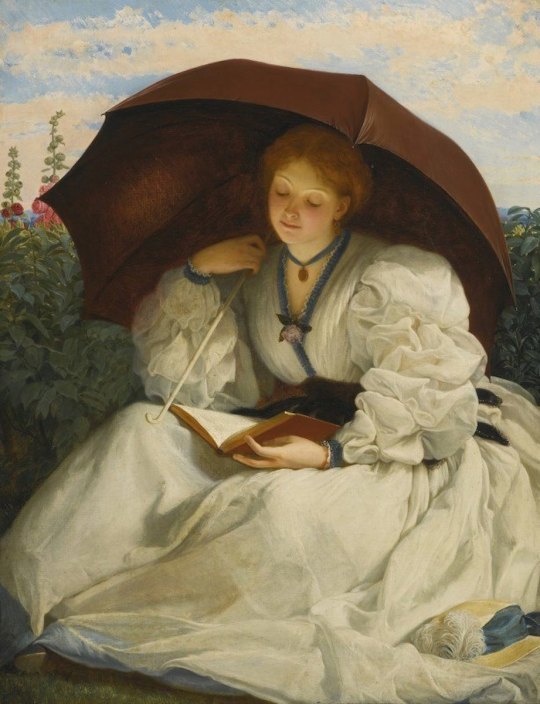
More 1860s -
Top left 1865-1868 Robe à transformation front by Maison Soinard (Musée des Arts décoratifs - Paris, France). From tumblr.com/jewellery-box.1128X1185.
Top right 1865-1868 Robe à transformation side by Maison Soinard (Musée des Arts décoratifs - Paris, France). From madparis.fr/10-frise-chronologique 2532X2440.
Second row 1866 Game Time by Gustave Léonard de Jonghe (sold by Ary Jean Art Gallery) 1800X1411.
Third row left 1866 Mrs. James Guthrie by Frederic Leighton (location ?). From tumblr.com/artthatgivesmefeelings 2017X3072.
Third row right 1866 María Leonor Salm-Salm, Duchess of Osuna by Carlos Luis de Ribera y Fieve (Museo Nacional del Romanticismo - Madrid, Spain) Google Art Project via Wm despot 3513X4257.
Fourth row Practicing by Gustave Léonard de Jonghe (location ?). From tumblr.com/artthatgivesmefeelings; fixed spots & flaws w Pshop 1910X1583.
Fifth row left 1869 (before) Fürstin Maria von Stackelberg by Anton Romanko (Dorotheum - 19th Century Paintings May-June 2021 Lot 521). From Wikimedia 1583X2048.
Fifth row right Reading on a Sunny Afternoon by Charles Edward Perugini (location ?). From tumblr.com/baroque-beauty-24; enlarged by half 921X1200.
#1860s fashion#early Victorian fashion#Second Empire fashion#Maison Soinard#crinoline#Gustave Léonard de Jonghe#hair ribbon#sheer sleeves#Mrs. James Guthrie#Frederic Leighton#María Leonor Salm-Salm#Carlos Luis de Ribera y Fieve#off shoulder straight neckline#waist band#Maria von Stackelberg#Anton Romanko#curly hair#tiara#lace bertha#Charles Edward Perugini#parasol#V neckline#Swiss belt
30 notes
·
View notes
Photo


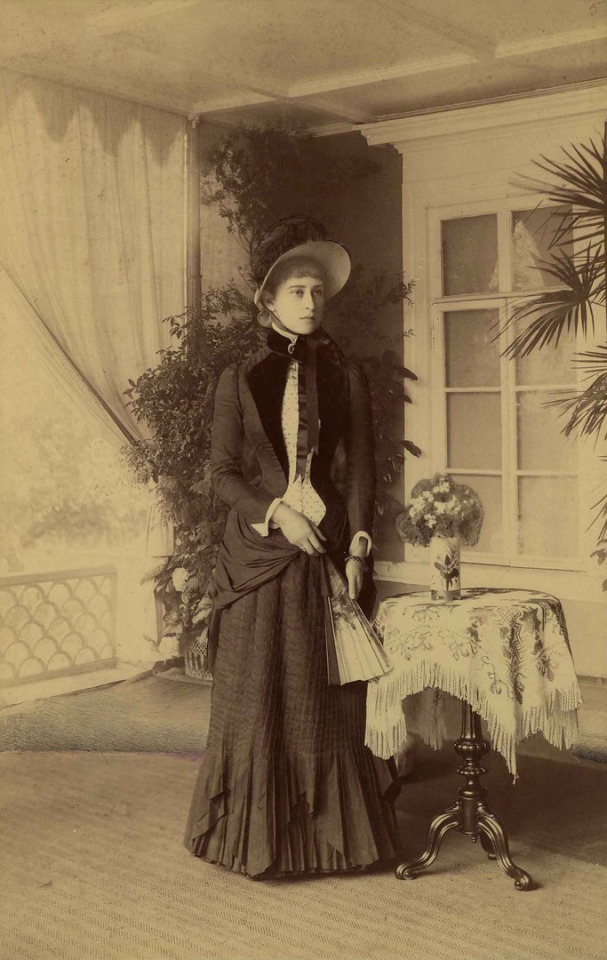
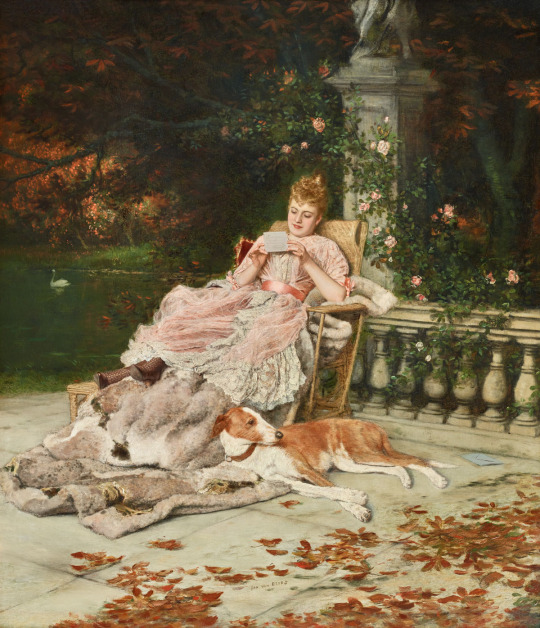
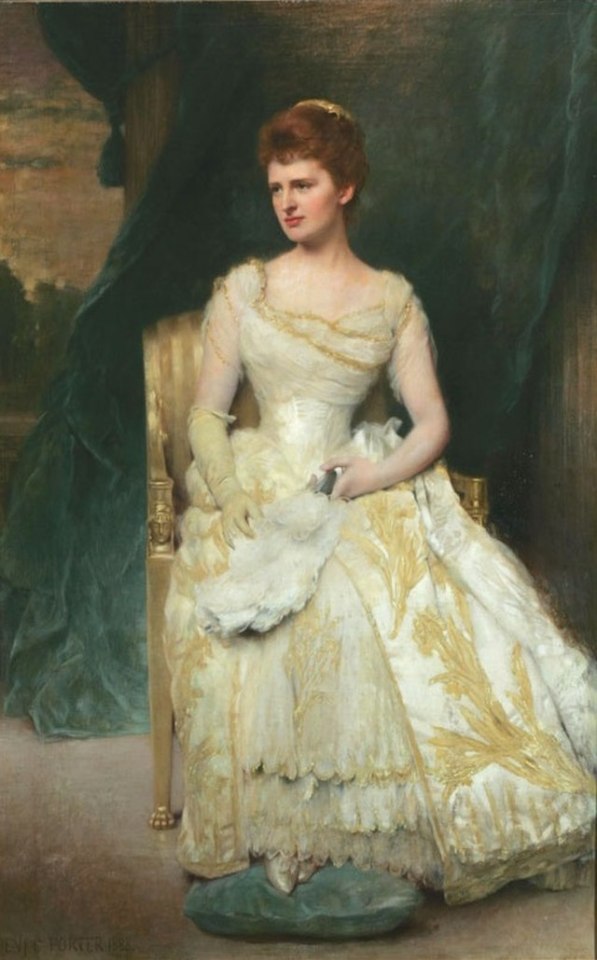

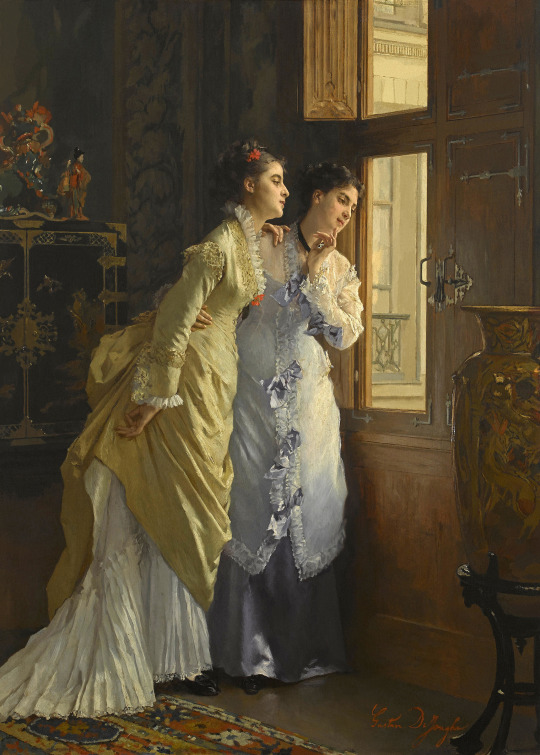



The 1880s -
Top 1880 La lettre d'amour by Joseph Scheurenberg (location ?). From tumblr.com/artthatgivesmefeelings 1477X1146. Fixing the wrinkles would do more to the image than leaving the wrinkles intact.
Second row left 1880 Noble Woman by Jan van Beers (location ?). From tumblr.com/toanunnery 757X1000 @72 183kj. Interesting Napoléonic-looking dress.
Second row right 1880s Grand Duchess Elizabeth Feodorovna of Russia. From tumblr.com/royaland; fixed spots w Pshop 683X1080. She was one of the beauties of her time. She was assassinated by the Bolsheviks and immortalized on the martyrs entrance to Westminster Abbey along with other heroic religious figures such as Oscar Romero and Martin Luther King Jr.
Third row 1883 (exhibited) Le billet doux by Jan-Van-Beers (on sale at Ary Jan Art Gallery). From their Web site; fixed most obvious spots & left side of upper edge 1200X1395.
Fourth row left 1888 Emily Thorn Vanderbilt Sloane (Vanderbilt University Fine Arts Gallery - Nashville, Tennessee, USA). From Google search 640X1030.
Fourth row right 1889 Elegant lady, seated three-quarter length, before a Lakeland landscape by Edward Hughes (auctioned). From mutualart.com/Artwork/Portrait-of-an-Elegant-Lady-Seated-Three/B11E6296D1FCE9A6 1834X2634.
Fifth row Awaiting the suitor by Gustave Léonard de Jonghe (location ?). From Yulia Mi's photostream on flickr; fixed spots & some cracks w Pshop 2060X2880.
Sixth row left Mary, Duchess of York, future Queen Consort of King George V, color by Klimbims. From tumblr.com/royaland 750X1213. This is the Lady honored by the large metal monument in Long Beach harbor in California.
Sixth row right Sweet dreams by Gustave Leonard de Jonghe (location ?). From Yulia Mi's photostream on flickr 1510X2048.
Seventh row The confidence by Ferdinand Heilbuth (on sale at Ary Jean Art Gallery). From their Web site; fixed biggest spots wPshop 1961X1467. The left side of the upper edge also needed fixing.
20 notes
·
View notes
Text
RET-bus (lijn 42) rijdt op de G.J. de Jonghweg richting Drooglever Fortuynplein op een vrije baan. Op de achtergrond het gebouw van de Academie van Beeldende Kunsten en Technische Wetenschappen en de toren van het Gemeente-Energiebedrijf (GEB). De foto is gemaakt tussen 27 en 30 oktober 1967.
Gerrit Johannes de Jongh (Willemstad, 4 juli 1845 - 's-Gravenhage, 31 januari 1917) was als directeur van de dienst Gemeentewerken "havenbouwer en stadsontwikkelaar" van Rotterdam.
De Jongh was de zoon van Teunis Gerardus de Jongh (1808-1847), officier van gezondheid, en Cornelia Johanna Maris (1803-1871).[2] Na middelbaar onderwijs volgde De Jongh van 1861 tot 1865 militaire en vaktechnische onderwijs aan de Koninklijke Militaire Academie te Breda.
Na afronding van zijn studie werd De Jongh benoemd tot 2e luitenant-ingenieur bij de genie. Hij werd aan het werk gezet bij de opbouw van de Nieuwe Hollandse Waterlinie als vestingbouwkundige. Hier werkte bij mee aan de herbouw van het Fort bij Uitermeer, waar op het terrein een torenfort werd gebouwd. Hij wist de technisch moeilijke constructie succesvol te realiseren, en trok daarmee de aandacht. In de opvolgende jaren realiseerde hij meerdere militaire bouwwerken en voerde ook enige particuliere opdrachten uit. In 1874 volgde een promotie tot kapitein.
In 1879 volgde voormalig genie-officier De Jongh C.B. van der Tak op als directeur Gemeentewerken. Al snel naar zijn aantreden als directeur Gemeentewerken in 1879, verwierf De Jongh een ongekend machtige positie. Rotterdam maakte op dat moment een zeer sterke groei door (zie ook: Geschiedenis van Rotterdam). In 1910 werd De Jongh als directeur opgevolgd door A.C. Burgdorffer. Na zijn afscheid van Rotterdam was De Jongh nog enige jaren lid van Provinciale Staten van 1910 tot 1916 en de Tweede Kamer van 1910 to 1913.
De fotograaf is Ary Groeneveld en de foto komt uit het Stadsarchief Rotterdam. De informatie komt van Wikipedia.
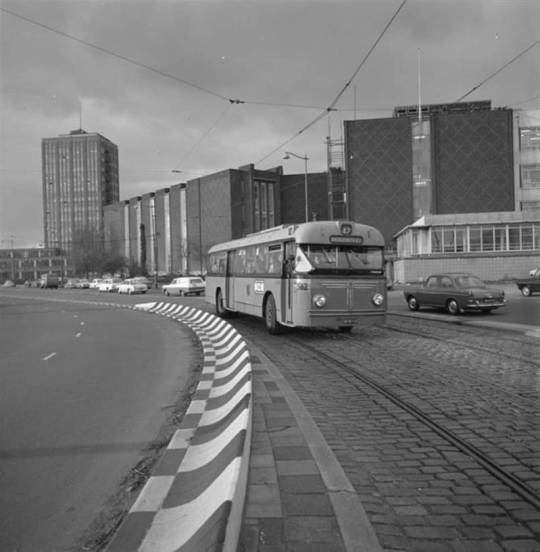
0 notes
Text
Theeschenkerij De Nachtegaal in het Kralingse Bos, 1969.
De directeur Gemeentewerken, G.J. de Jongh, ontwerpt in het begin van de 20e eeuw een plan voor een bos of stadspark langs de Noorderplas, zoals de Kralingse Plas in die tijd wordt genoemd. De oorspronkelijke naam van het park is de Kralinger Hout. In 1911 wordt het plan door de gemeenteraad aangenomen. Men zal de polders ophogen met slib en baggerspecie die men over zal hebben van het graven van de Waalhaven.
Doordat de aanleg van de haven door de Eerste Wereldoorlog vertraging oploopt, duurt het even voordat de plannen van de grond komen. In 1921 maakt de architect Marinus Jan Granpré Molière een nieuw ontwerp. Vanaf 1928 is de grond eindelijk voldoende opgehoogd, en begint men met het planten van speciaal in Noord-Brabant gekweekte eiken. De Rotterdamse schooljeugd wordt hierbij ingezet op speciale boomplantdagen. In de jaren dertig van de 20e eeuw worden er in het kader van de werkverschaffing ook werkelozen ingezet bij de aanleg en beplanting. Een groot deel van deze bomen wordt tijdens de hongerwinter opgestookt in de kachel. Het vele puin, afkomstig uit het centrum van de gebombardeerde stad, wordt gedumpt in de zuidelijke hoek van de Plas. Zo ontstaat een groep kleine eilanden, die ten behoeve van wandelaars worden verbonden met een reeks loopbruggen. In 1953 wordt het Kralingse Bos dan eindelijk officieel geopend.
Het bos verwerft grote bekendheid in de zomer van 1970 vanwege het Holland Pop Festival, het 'Europese antwoord op Woodstock'. Internationale bands die er optreden zijn onder meer Pink Floyd, The Byrds, Santana en Focus. In totaal zijn er meer dan 100.000 bezoekers.
De fotograaf is Ary Groeneveld en de foto komt uit het Stadsarchief Rotterdam. De informatie komt van Wikipedia.

0 notes
Text
Het kantoor van Van Ommeren aan de Westerkade op de hoek met de Westerlaan, 1967.
De Rotterdamse rederij Van Ommeren beschikte in de jaren vijftig over een hoofdkantoor dat aan de Westerlaan was ondergebracht in een rijtje gedateerde panden aan de Westerlaan, die onderling waren verbonden met trappen en gangen. In 1957 werd besloten tot de bouw van een nieuw modern kantoorgebouw op de zelfde locatie, nadat plannen om dichter bij het centrum of op De Heuvel in Het Park te bouwen niet door gingen.
Het architectenbureau Verhave - Luyt - De Jongh was verantwoordelijk voor het ontwerp van het nieuwe kantoorgebouw bestaande uit een hoge toren en een lang laag blok aan de Westerlaan. Eerst werd op de braakliggende hoek van Westerlaan en Calandstraat de hoogbouw gerealiseerd terwijl de kantoren in de oude panden in gebruik bleven. Deze maakten pas plaats voor de laagbouw toen het torengebouw betrokken kon worden. Dat resulteerde in een lange bouwtijd: de uitvoering door aannemer J.P. van Eesteren begon in december 1958; de toren werd medio april 1962 in gebruik genomen; de laagbouw van het gebouwencomplex werd in 1965 voltooid. De toren was zestien verdiepingen hoog en voorzien van een helikopterplatform, dat overigens al snel onbruikbaar bleek te zijn wegens problemen met turbulentie en andere veiligheidsproblemen. Ook beschikte het bedrijf aan de Westerkade over een nog steeds aanwezig speciaal gegraven haventje voor directie- en inspectievaartuigen. Het aangrenzende kantoorgebouw aan de Westerkade, dat op de begane grond een doorgang heeft naar het achterliggende parkeerterrein van toen nog Van Ommeren is ook in 1965 gerealiseerd door dezelfde architect en aannemer.
De fotograaf is Ary Groeneveld en de foto komt uit het Stadsarchief Rotterdam. De informatie komt van Wikipedia.
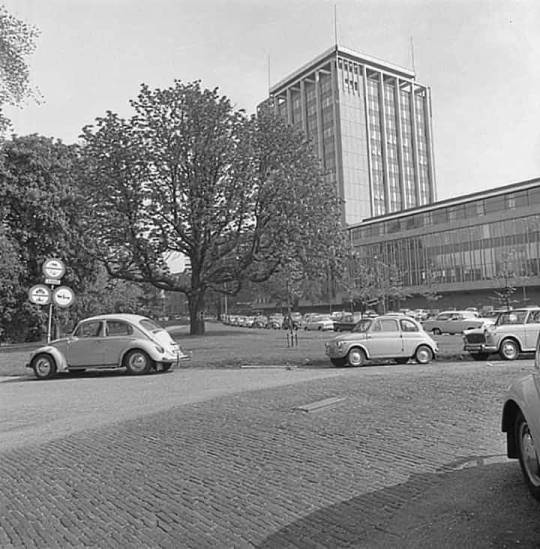
0 notes
Text
Het kantoor van Van Ommeren aan de Westerkade op de hoek met de Westerlaan, 1967 (geschat).
De Rotterdamse rederij Van Ommeren beschikte in de jaren vijftig over een hoofdkantoor dat aan de Westerlaan was ondergebracht in een rijtje gedateerde panden aan de Westerlaan, die onderling waren verbonden met trappen en gangen. In 1957 werd besloten tot de bouw van een nieuw modern kantoorgebouw op de zelfde locatie, nadat plannen om dichter bij het centrum of op De Heuvel in Het Park te bouwen niet door gingen.
Het architectenbureau Verhave - Luyt - De Jongh was verantwoordelijk voor het ontwerp van het nieuwe kantoorgebouw bestaande uit een hoge toren en een lang laag blok aan de Westerlaan. Eerst werd op de braakliggende hoek van Westerlaan en Calandstraat de hoogbouw gerealiseerd terwijl de kantoren in de oude panden in gebruik bleven. Deze maakten pas plaats voor de laagbouw toen het torengebouw betrokken kon worden. Dat resulteerde in een lange bouwtijd: de uitvoering door aannemer J.P. van Eesteren begon in december 1958; de toren werd medio april 1962 in gebruik genomen; de laagbouw van het gebouwencomplex werd in 1965 voltooid. De toren was zestien verdiepingen hoog en voorzien van een helikopterplatform, dat overigens al snel onbruikbaar bleek te zijn wegens problemen met turbulentie en andere veiligheidsproblemen. Ook beschikte het bedrijf aan de Westerkade over een nog steeds aanwezig speciaal gegraven haventje voor directie- en inspectievaartuigen. Het aangrenzende kantoorgebouw aan de Westerkade, dat op de begane grond een doorgang heeft naar het achterliggende parkeerterrein van toen nog Van Ommeren is ook in 1965 gerealiseerd door dezelfde architect en aannemer.
De fotograaf is Ary Groeneveld en de foto komt uit het Stadsarchief Rotterdam. De informatie komt van Wikipedia.

0 notes
Text
Theeschenkerij De Nachtegaal in het Kralingse Bos, 1969 (geschat).
De directeur Gemeentewerken, G.J. de Jongh, ontwerpt in het begin van de 20e eeuw een plan voor een bos of stadspark langs de Noorderplas, zoals de Kralingse Plas in die tijd wordt genoemd. De oorspronkelijke naam van het park is de Kralinger Hout. In 1911 wordt het plan door de gemeenteraad aangenomen. Men zal de polders ophogen met slib en baggerspecie die men over zal hebben van het graven van de Waalhaven.
Doordat de aanleg van de haven door de Eerste Wereldoorlog vertraging oploopt, duurt het even voordat de plannen van de grond komen. In 1921 maakt de architect Marinus Jan Granpré Molière een nieuw ontwerp. Vanaf 1928 is de grond eindelijk voldoende opgehoogd, en begint men met het planten van speciaal in Noord-Brabant gekweekte eiken. De Rotterdamse schooljeugd wordt hierbij ingezet op speciale boomplantdagen. In de jaren dertig van de 20e eeuw worden er in het kader van de werkverschaffing ook werkelozen ingezet bij de aanleg en beplanting. Een groot deel van deze bomen wordt tijdens de hongerwinter opgestookt in de kachel. Het vele puin, afkomstig uit het centrum van de gebombardeerde stad, wordt gedumpt in de zuidelijke hoek van de Plas. Zo ontstaat een groep kleine eilanden, die ten behoeve van wandelaars worden verbonden met een reeks loopbruggen. In 1953 wordt het Kralingse Bos dan eindelijk officieel geopend.
Het bos verwerft grote bekendheid in de zomer van 1970 vanwege het Holland Pop Festival, het 'Europese antwoord op Woodstock'. Internationale bands die er optreden zijn onder meer Pink Floyd, The Byrds, Santana en Focus. In totaal zijn er meer dan 100.000 bezoekers.
De fotograaf is Ary Groeneveld en de foto komt uit het Stadsarchief Rotterdam. De informatie komt van Wikipedia.
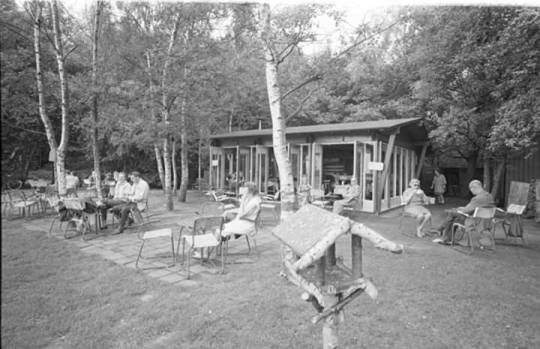
0 notes